
Commercial Coffee Roaster Buying Guide
Shop All Commercial Coffee Roasters
Types of Coffee Roasters
Drum coffee roasters and fluid bed coffee roasters are the two main types of commercial coffee roasters used by professionals. Drum coffee roasters are more widely used and utilize conduction and convection heating to roast beans. Fluid bed coffee roasters only utilize convection heating and are gaining popularity for their smooth, even roasting.
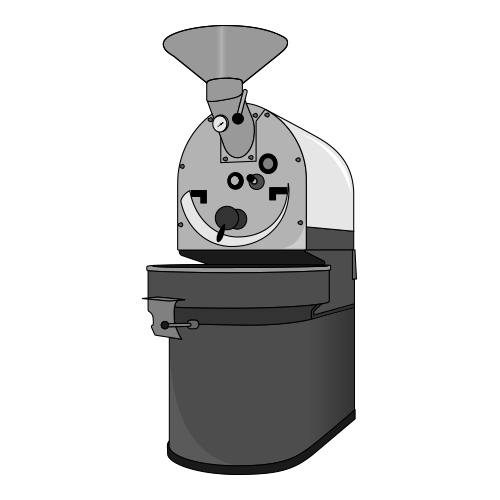
Drum Coffee Roaster
The most popular and economical type of roaster is a commercial drum coffee roaster. This roaster machine features a solid drum that rotates over a gas flame to heat the coffee beans. The beans receive both conductive heat transfer by making direct contact with the surface of the drum and convection heat transfer from the ambient air inside the drum. Drum roasters have paddles inside the drum to mix the beans as the drum rotates and ensure they receive the right blend of conductive and convective heat.
Drum coffee roasters come in two types: single-wall drums and double-wall drums. A single-wall drum roaster is the classic type of drum roaster, whereas the outer wall of a double-wall drum roaster uses air to heat the inner wall and provide a more stable roasting experience. Generally, a drum roaster is easy to control and manipulate. However, if too much heat transfers to the beans via direct contact with the drum or the speed of the rotating drum is set too high, the coffee beans can end up scorched and their flavor distorted.
- Gives the beans a deep, full-bodied flavor
- Applies both conductive and convective heat sources to roast beans
- Flexibility in control
- Available in single-wall and double-wall styles for preference
- Comes in a variety of sizes
- Ideal for high-volume roasting
- Some beans may get burnt in the roasting process when they have direct contact with the drum
- Can be harder to duplicate roast profiles
- Longer roasting time than fluid bed coffee roasters
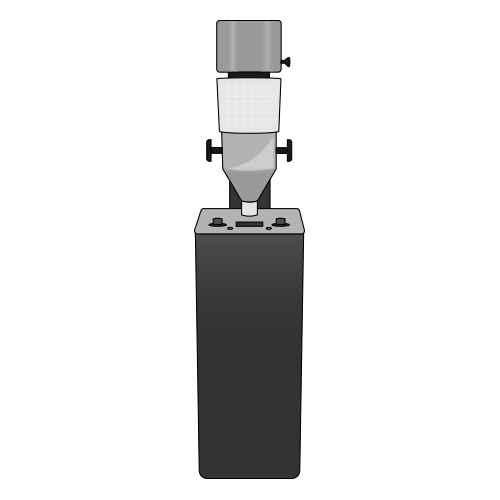
Fluid Bed Coffee Roaster
A fluid bed coffee roaster relies solely on convection heat transfer to roast coffee beans. It consists of a tall cylinder where hot air rises through a chamber into the roaster and causes the coffee beans to float in a fluidized bed of hot air to roast them. A fluid bed coffee roaster is typically electric, which can be great for companies trying to reduce their carbon footprint.
Compared to drum roasters, fluid bed roasters are known for roasting coffee beans more evenly and in a quicker amount of time as the air has complete and constant contact with them. These roasters eliminate the risk of scorching associated with conductive heat since the beans do not come in direct contact with the roaster. They are usually compact machines, making them ideal for small-batch roasting.
- Roasts coffee faster and with less energy than drum roasters
- Provides more even heat distribution and a more consistent roast
- Less likely to scorch beans
- Compact size is ideal for small roasteries
- Not ideal for high-volume batches
- Typically more expensive
- Harder to produce a full-bodied coffee flavor than with drum roasters

We offer ready-to-ship roasters that are available in a pre-configured format and custom coffee roasters that have some core customization options to provide more control over the look and functionality of the roaster.
Conduction vs Convection in Coffee Roasting
The coffee roasting process involves heating the coffee beans to induce the Maillard reaction and bring out a coffee bean's unique flavor profile. Roasting transforms the coffee bean from its green, grassy, and bitter raw state into the brown, fragrant, and complex bean people love. Along with the type of roaster used, the heating method used will also impact the development of the coffee's characteristics. Fluid bed roasters solely rely on convective heat to roast the coffee beans, and drum roasters use a mix of conductive and convective heat.
What Is Conductive Heat?
Conductive heat occurs when heat transfers between two objects in contact with each other. When roasting coffee, this refers to when the beans come into contact with the hot metal surface of a drum roaster. Conductive heat transfer is a more traditional style of roasting that roasts the beans from the outside in, similar to cooking meat in a frying pan.
What Is Convective Heat?
Convective heat is the transfer of heat through a liquid or gas. When roasting coffee, this refers to when heat is applied indirectly to the beans via hot air. Coffee roasters use a fan or pump to pull air into the roaster and heat the beans. Convective heat transfer is a more modern and upcoming style of roasting that roasts the inside out, similar to baking.
Electric vs Gas Coffee Roaster
Electricity and gas are two different heating methods that can power coffee roasters. The main difference between electric coffee roasters and gas coffee roasters is their responsiveness to heat changes. Gas roasters can change temperatures quickly, whereas electric roasters respond more slowly. Both can produce high-quality coffee beans, so the type of fuel you choose will mostly rely on preference and location.
Electric Coffee Roaster
- More energy efficient
- Does not require a gas line and is more flexible in placement
- Little to no emissions
- Programming provides more consistency
- No permits required
- The heating element takes longer to heat up and cool down
- Typically have a more expensive upfront cost
Gas Coffee Roaster
- Provide precise control
- Change temperatures faster
- More size options are available
- More powerful
- Not as energy efficient
- Requires a gas line and permits
What to Consider When Purchasing a Commercial Coffee Roaster
Before purchasing a commercial coffee roaster, the main factors you will need to determine are how much coffee you will produce in a day, your budget, and how much control you would like to have over the roasting process.
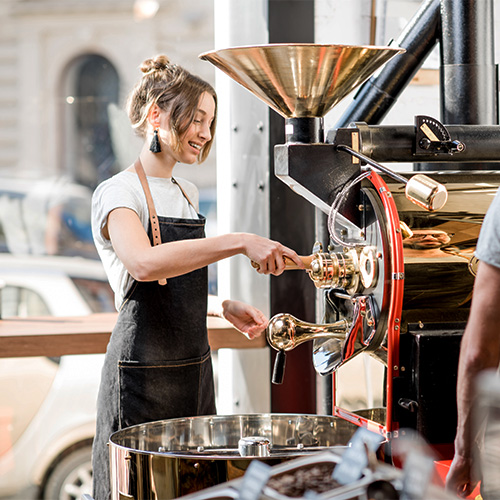
- Size - To determine which size roaster you will need, you will want to consider the drum capacity of the unit. A small, independent coffee shop may only need a roaster with a 3 kg drum capacity versus a roastery servicing multiple locations that may require a coffee roaster with a large drum capacity of 30 kg.
- Price - While your budget should be a consideration when purchasing any coffee shop equipment, you should also keep in mind how often you will be using your roaster, who will be operating the roaster, and the features you need when determining the cost. While high-quality roasters are generally more expensive, they have more advanced technology and are easier to use.
- Features - If you want complete control over the roasting process, look for roasters with manual flame, drum speed, and airflow control features. Compatibility with roast profiling software is another helpful feature to ensure that every batch will produce the same quality, regardless of who operates the machine.
- Ease of Use - If you operate a higher-volume establishment where multiple people will be running the roaster in a day, you will need a roaster with easy-to-use controls.
Benefits of Roasting Coffee In-House
It is no wonder that in-house roasting is trending in coffee shops as operators look for ways to improve their products and customer loyalty. It will allow you to serve the freshest coffee possible for a superior taste but also increase engagement with your local community. Roasting in-house can also enhance your coffee shop's interior and create a more interactive experience for your customers. Let's break down some of the benefits of roasting coffee in-house below:
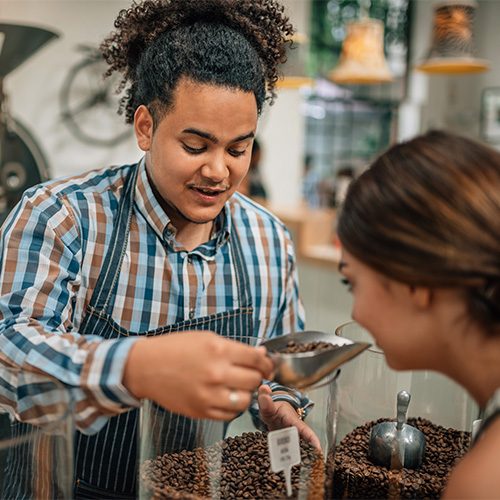
- Fresher Product - The freshness of your coffee is a huge selling point to your customers. A unique, superior-roasted bean might mean converting a one-time or occasional customer to a devoted, loyal customer for years to come.
- Better Control - By bringing your coffee roasting in-house, you can control the entire coffee-making process, from developing the coffee's roast profile to controlling its grind size and brewing method. By controlling the coffee's quality from beans to brewing, you can ensure the coffee's taste profile is to your liking and provide a unique product to your patrons.
- Transparency - By aligning with customers' values, such as shopping local and preserving a coffee region's characteristics, you can attract new customers by roasting in-house. Consider purchasing fair trade or single-origin coffee to increase your establishment's transparency and ensure your beans come from a reputable, ethical source.
- Wholesale Opportunities - Creating your own signature roasts and blends allow you to market bags of freshly-roasted beans to consumers in your shop, sell them online, and create a coffee subscription service. You can also sell your different coffee roasts to other local businesses to increase brand recognition in your area.
Related Resources

Types of Coffee Makers
Coffee's global popularity makes it a great item to bring onto your menu to expand your offerings or provide as an amenity at your office to boost the employee or guest experience. This guide will go over the types of coffee brewers and their pros and cons, so you can choose the best coffee maker for your needs. Be sure to check out our commercial coffee machine reviews as well!
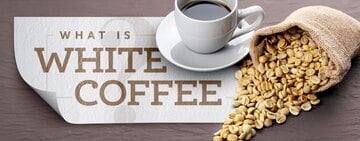
Everything You Need To Know About White Coffee
When it comes to coffee, there are various roasts and blends to choose from. One roast that has been gaining popularity over the years is white coffee. But what exactly is white coffee, and what makes it different from regular coffee? Not to be confused with Malaysian white coffee or a flat white, which are types of coffee drinks , white coffee has a distinct flavor that makes it a great option for those looking for something new and exciting. What Is White Coffee? White coffee gets its name from its unique roasting process, which involves roasting coffee beans at a lower temperature for a shorter time than other coffee roasts . This results in a lighter color and a milder flavor profile. Unlike other coffee roasts where the beans have a me
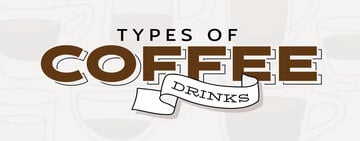
Types of Coffee Drinks
If you have ever been to a cafe or coffee shop, you know the drink menu is often overwhelming. As a coffee shop owner, there are so many types of coffee drinks you can offer your customers that it's difficult to understand the difference between them. We explored the most popular coffee drinks and their recipes so you can get familiar with them and keep up with current coffee trends . Click the following link to check out our printable coffee drinks chart. Use these links to jump ahead and find out how your favorite coffee drink is made. Espresso Double Espresso Red Eye Black Eye Americano Long Black Macchiato Long Macchiato Cortado Breve Cappuccino Flat White Cafe Latte Mocha Vienna Affogato Cafe au Lait Iced Coffee Brewing Styles Compared
- Topics 1356
- Industrial 55
- Troubleshooting Guides 21
- Restaurant Management 128
- Bar Management 56
- Catering Tips 36
- Bakery Management 42
- Food Trucks & Concessions 49
- Advertising & Marketing 37
- Eco-Friendly Tips 11
- Facility Layout & Design 42
- Coffee Shop Tips 28
- Installation & Maintenance 51
- Janitorial & Pest Control 30
- Safety & Sanitation 88
- Startup Tips 104
- Menu Design 10
- Kitchen & Cooking Tips 83
- Hospitality Management 24
- Pizza & Sandwich Shop Tips 36
- Smallwares 37
- Food Prep 89
- Tabletop Items 17
- Disposables 22
- Calculators & Tools 6
- Consumables 52
- Warewashing & Laundry 19
- Cooking Equipment 91
- Food Storage & Refrigeration 51
- Beverage Equipment 35
- Office Supplies 6
- Resource Type
- In-Depth Articles272
- Buying Guides298
- How-Tos95
- Product Reviews78


